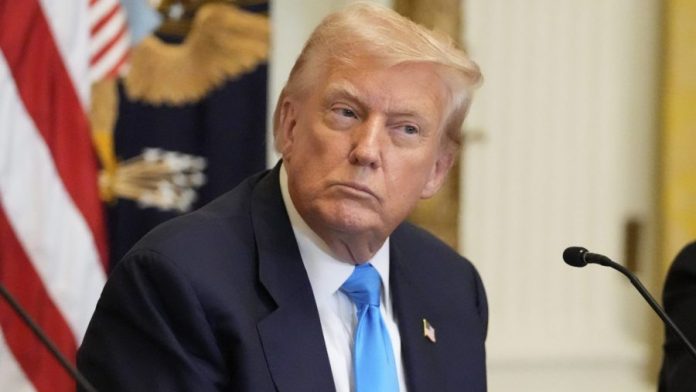
An appeals court on Thursday scrutinized President Trump’s assertion that emergency powers justify his worldwide tariffs.
Thursday’s high-stakes oral argument before the U.S. Court of Appeals for the Federal Circuit came one day ahead of Trump’s deadline for dozens of countries to strike trade deals or face higher “reciprocal” duties.
To justify the sweeping moves, Trump cites the International Emergency Economic Powers Act (IEEPA), a 1977 law authorizing the president to issue certain economic sanctions in an emergency to counter an “unusual and extraordinary threat.”
“It’s just hard for me to see that Congress intended to give the president in IEEPA the wholesale authority to throw out the tariff schedule that Congress has adopted after years of careful work and revise every one of these tariff rates,” said Judge Timothy Dyk.
“It’s really kind of asking for an extraordinary change to the whole approach,” continued Dyk, an appointee of former President Clinton.
Presidents have invoked other statutes to impose tariffs, but Trump in February became the first president to attempt to do so by invoking the emergency law.
“Why is that?” pressed Judge Jimmie Reyna, an appointee of former President Obama. “Has there been no national emergency?”
The Justice Department argues that IEEPA has for decades been among the “most powerful tools” a president can use to protect national security, foreign policy and the economy.
Brett Shumate, assistant attorney general for the Justice Department’s civil division, said Congress has long given presidents “broad discretion” to deal with national emergencies and that IEEPA is a tool that lets Trump to put pressure on trading partners.
“Congress wanted to provide broad and flexible authority in the context of emergencies, and I think you have to read the phrase ‘regulate importation’ in the context of an extraordinary delegation of power to the President that can be checked by Congress in specific cases,” Shumate said, pointing to specific language also used by President Nixon to impose tariffs in 1971.
Chief Judge Kimberly Moore, an appointee of the second former President Bush, asked if it amounts to a “bargaining chip.”
“Exactly,” Shumate replied.
Trump first used IEEPA in February to announce levies on Canada, China and Mexico — pointing to the fentanyl crisis as the emergency — but, in April, the president expanded to a 10 percent global baseline tariff, with higher rates for some countries. The expansion, deemed “Liberation Day” by Trump, was attributed to an emergency over trade deficits.
The lawsuit was brought by 12 Democratic-led states and five small businesses. The administration appealed after the U.S. Court of International Trade invalidated the levies, and the Federal Circuit has allowed the tariffs to remain in effect until deciding the case.
Neal Katyal, a lawyer for the businesses, began his argument with a warning that the government believes Trump can do “whatever he wants, whenever he wants, for as long as he wants,” so long as he declares a national emergency.
The tariffs amount to a “breathtaking claim to power” not asserted by any president in 200 years, and one with “staggering” consequences, Katyal said.
The plaintiffs argue IEEPA can’t be read to endorse tariffs. But even if that reading is possible, the plaintiffs point to a series of decisions from the Supreme Court’s conservative justices holding that the executive branch must have clear congressional authorization to carry out matters of significant economic and political significance.
“This is not an elephant in a mouse hole,” said Katyal, invoking a phrase the justices often use to explain the principle, known as the major questions doctrine.
“This is a galaxy in a keyhole,” he continued.
Though Katyal, a high-profile Supreme Court advocate who served as solicitor general under former President Obama, garnered sympathy with his concerns, several judges took issue with the plaintiffs’ position that trade deficits aren’t a valid emergency because they have existed for decades.
Those judges suggested the challengers were sidestepping how Trump’s tariff order additionally points to recent consequences of the deficits, like a hollowed-out U.S. manufacturing base and undermined critical supply chains. Moore, the chief judge, at one point chastised the states’ attorney for claiming Trump had only talked about it in a single sentence.
“I will walk it back,” Benjamin Gutman, Oregon’s solicitor general, conceded.
The arguments come on the eve of the cutoff Trump established for nearly 200 countries to strike a deal to avoid higher rates on goods.
Trump reached agreements with South Korea and the European Union this week setting tariffs at 15 percent, and last week, he reached similar deals with Japan and the Philippines. Trump on Thursday announced Mexico’s tariffs would be extended at current rates for another 90 days, while other countries have until Aug. 1 to make a deal with the president or face the heavier rates.
Nearly 100 people, mostly attorneys, filled the second-floor courtroom Thursday where 11 of the Federal Circuit’s 12 active judges weighed Trump’s tariffs.
Judge Pauline Newman, the nation’s oldest federal judge at 98, did not participate; she was suspended by her fellow judges from hearing new cases over concerns about her mental fitness, which she has challenged in court. However, she was seated in the public gallery for the arguments along the aisle in the second row.
Ahead of the hearing, Trump on Truth Social wished his lawyers “good luck in America’s big case.”
“If our Country was not able to protect itself by using TARIFFS AGAINST TARIFFS, WE WOULD BE ‘DEAD,’ WITH NO CHANCE OF SURVIVAL OR SUCCESS,” the president said.

